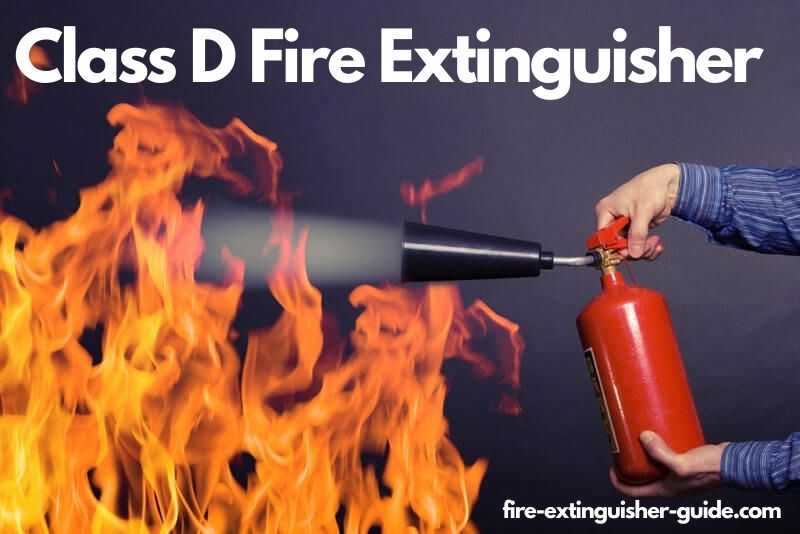Class D Fire Extinguisher Used For?
A fire involving ombustible metals, such as aluminum, titanium, magnesium, lithium, zirconium, sodium, and potassium is called type D fire, and the Extinguisher used to extinguish this fire is known as a Class D Fire Extinguisher.
The fuel source is what determines the class. The fire class defines the type of extinguishing agent or extinguisher that will most effectively put out the fire.
The Class D fire is a lesser-known fire and is not as widespread. Class D fires are hazardous and will require particular types of Fire extinguisher.
Continue reading to learn more about a Class-D fire and which extinguishers are classified as such.

What is Class D Fire?
Class D fires are caused by combustible metals like aluminum, magnesium, lithium, and zirconium.
These fires are usually found in manufacturing or industrial settings.
The metal fines, which are small, thin, metal pieces that ignite during machining, become the fuel element of the fire triangle (fuel oxygen heat plus a chemical reaction).
Class D fires are difficult to extinguish and can cause severe damage.
What Types of Extinguishers are Rated as Class D Fire Extinguishers?
Unfortunately, Class D fires can’t be simply extinguished using water or another extinguishing agent. Water reacts with explosive metal, intensifying the fire, increasing heat, and spreading molten material.
Class D fire extinguisher must be used to extinguish a combustible metallic fire. Smothering these fires and eliminating the oxygen element is the best to put them out. It also absorbs heat from the fuel.
Dry Powder Fire extinguisher
The Dry Powder extinguisher has been the only Class D fire extinguisher. Powdered graphite (granular sodium chloride) or copper-based powder agents effectively separate the fuel (the ignited metal) from oxygen.
Dry powder extinguishers can be effective for Class D fires but not for other classes of fire.
People working with combustible metals must be familiar with the unique properties of Class D fires and how to safely use a Class D extinguisher.
Class D Fire Extinguisher training (Video)

Here is tep by step guide of How to Use a Fire Extinguisher? in detail.
Fighting Class-D Fires
Water cannot be used on metal-burning fires. This is similar to class C flames. Spraying water onto a class D fire can actually energize it, spreading heat and causing additional damage.
Dry powder extinguishing agent are the best way to put out class D fires. They absorb heat and smother flames, thus cutting off oxygen. The fire can be quickly and safely extinguished by removing the two essential elements of the fire tetrahedron.
Protecting your home or business from Class D fires
Fires that are fueled by metal are very rare. However, it is important to be aware of the possible risks. A small fire of class D can quickly become dangerous because people don’t expect metal to burn and the flames spread so fast. It is important to educate your family and staff about the dangers and conditions of this type of fire.
Make sure you have fire extinguishing equipment that is rated for combustible materials in your business or home. If those metals are in small, easily ignited forms (such as dust or shavings), you should avoid sparking and design the space according to the applicable standards and codes.
Class D fires can quickly spread with frightening intensity and are extremely dangerous. Make sure you are well-informed about how to fight the flames, and what situations can cause a fire. Check out complete details of What do the Symbols on a Fire Extinguisher Indicate?
Check Full details of different Fire Extinguisher
- Class A Fire Extinguisher
- Class B Fire Extinguisher
- Class C Fire Extinguisher
- Class D Fire Extinguisher
- Class K Fire Extinguisher
- Kitchen Fire Extinguisher
FAQs
What is a Class D fire extinguisher good for?
Class D fires only involve combustible metals – magnesium, sodium (spills and in-depth), sodium-potassium alloys, potassium, uranium, and powdered aluminum.
What does class D stand for in fire?
A class D fire fire involves in burning of some extraordinary metals such as sodium, aluminum, potassium, magnesium, lithium, titanium, zirconium and some of their alloys.
What is D type fire?
The fire from combustible metals, such as aluminum, titanium, magnesium, lithium, zirconium, sodium, and potassium, is called Class D fire.
What is an example of a Class D fire?
A Class D fire has burning metals. Only certain metals can be flammable, and examples of combustibles include lithium, sodium, potassium, and uranium. The most common Class-D fires are magnesium or titanium.
Is Class D fires can be extinguished with water?
NO, Class D fires cannot be extinguished with water or just any extinguishing agent.
What causes Class D fires?
Class D fires are more common in industrial or commercial environments, where metalwork such as drilling or cutting is done. The following combustible metals can be found: magnesium, potassium, lithium, and lithium.
This article I have created to give you the complete information about the Class D Fire Extinguisher.
Check out the given all details which helps you to know about the Class D Fire Extinguisher.
If you want to learn more about fire extinguisher, You can visit our website: fire-extinguisher-guide.com
For More Information Visit https://en.wikipedia.org/wiki/Fire_extinguisher
